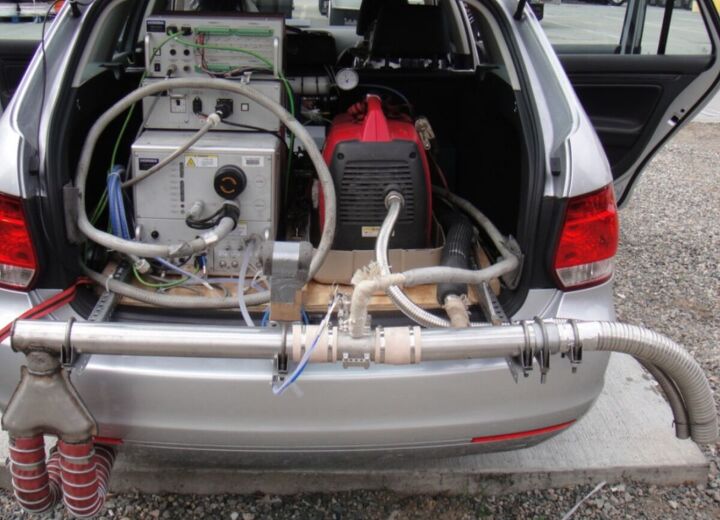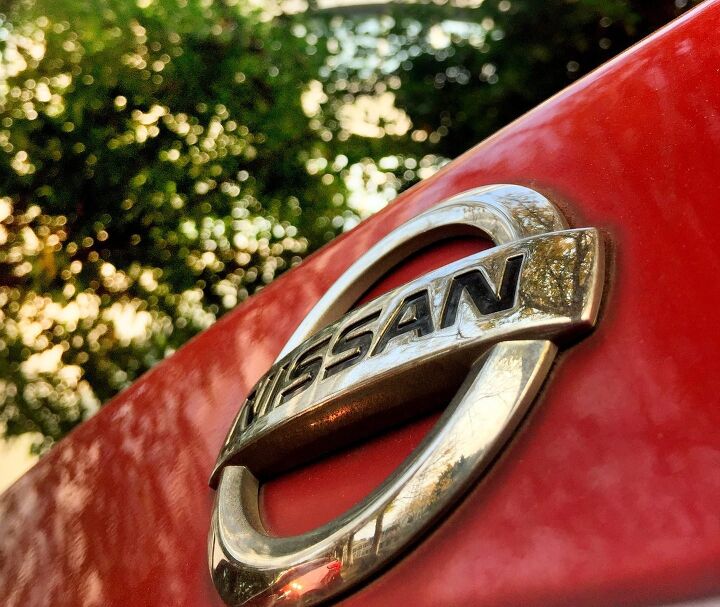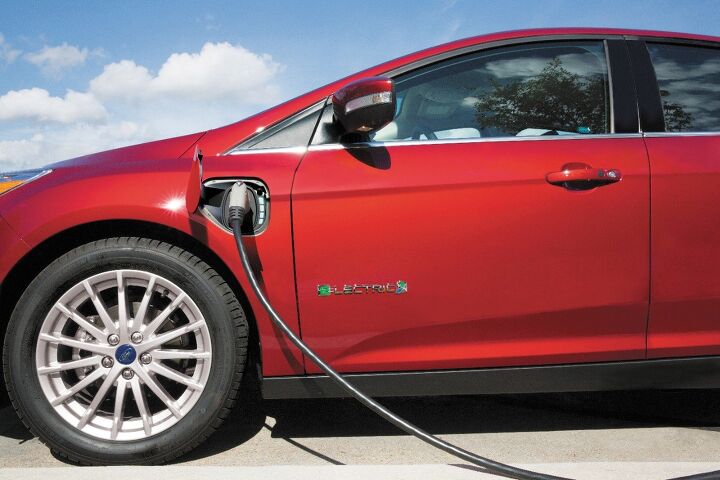#Regulations
Light It Up: Canucks to Mandate Taillight Illumination
It’s a problem — one I’m sure you’ve witnessed. A hapless driver, plodding along a darkened highway with no taillights illuminated, mistakenly thinking their lights are on thanks to a bright dashboard and flaccid daytime running lights.
High on poutine and maple syrup, Transport Canada is having no more of it, announcing a new mandate requiring all new cars sold in the Great White North to have extra illumination starting in 2021.
The initiative also proves that someone within the Canadian government has a sense of humour, as Transport Canada says they’re going “ghostbusting to target phantom vehicles.” Break out the ECTO-1!
Video of the Autonomous Uber Crash Raises Scary Questions, Important Lessons
On Wednesday evening, the Tempe Police Department released a video documenting the final moments before an Uber-owned autonomous test vehicle fatally struck a woman earlier this week. The public response has been varied. Many people agree with Tempe Police Chief Sylvia Moir that the accident was unavoidable, while others accusing Uber of vehicular homicide. The media take has been somewhat more nuanced.
One thing is very clear, however — the average person still does not understand how this technology works in the slightest. While the darkened video (provided below) does seem to support claims that the victim appeared suddenly, other claims — that it is enough to exonerate Uber — are mistaken. The victim, Elaine Herzberg, does indeed cross directly into the path of the oncoming Volvo XC90 and is visible for a fleeting moment before the strike, but the vehicle’s lidar system should have seen her well before that. Any claims to the contrary are irresponsible.
Unpacking the Autonomous Uber Fatality as Details Emerge [Updated]
Details are trickling in about the fatal incident in Tempe, Arizona, where an autonomous Uber collided with a pedestrian earlier this week. While a true assessment of the situation is ongoing, the city’s police department seems ready to absolve the company of any wrongdoing.
“The driver said it was like a flash, the person walked out in front of them,” explained Tempe police chief Sylvia Moir. “His first alert to the collision was the sound of the collision.”
This claim leaves us with more questions than answers. Research suggests autonomous driving aids lull people into complacency, dulling the senses and slowing reaction times. But most self-driving hardware, including Uber’s, uses lidar that can functionally see in pitch black conditions. Even if the driver could not see the woman crossing the street (there were streetlights), the vehicle should have picked her out clear as day.
Self-Driving Uber Vehicle Fatally Strikes Pedestrian, Company Halts Autonomous Testing
In the evening hours of March 18th, a pedestrian was fatally struck by a self-driving vehicle in Tempe, Arizona. While we all knew this was an inevitability, many expected the first casualty of progress to be later in the autonomous development timeline. The vehicle in question was owned by Uber Technologies and the company has admitted it was operating autonomously at the time of the incident.
The company has since halted all testing in the Pittsburgh, San Francisco, Toronto, and greater Phoenix areas.
If you’re wondering what happened, so is Uber. The U.S. National Transportation Safety Board (NTSB) has opened an investigation into the accident and is sending a team to Tempe. Uber says it is cooperating with authorities.
Green for Green: California Governor Outlines $2.5 Billion Electric Vehicle Push
If California’s Jerry Brown is known for anything, it’s for continuing his familial legacy of governing the region for a weirdly long period of time and pressing for the proliferation of electric vehicles. While not all of the state’s EV initiatives have gone without a hitch (the LAPD’s unused fleet of battery powered BMWs springs to mind), Brown remains essential in keeping his neck of the woods on the forefront of alternative energy adoption.
Currently, California plans to place five million zero-emission vehicles on the road by 2030. The state previously set a target of 1.5 million ZEVs by 2025. That’s a massive increase, especially considering California only has about 350,000 examples currently plying its roads. Don’t worry, Brown has a plan to stimulate sales: $200 million worth of subsidies per year for the next eight years.
Germany and Italy Oppose Stiffer European Car Approval Rules
Italy and Germany are opposing attempts to give the European Union more authority over the way national car regulators approve new cars for sale. As wild as it is to learn that Germany is standing in the way of stricter automotive regulation and oversight, allow us to assure you that you’ve not misread the above statement. For some reason, Deutschland doesn’t want to see enhanced industry surveillance.
Our best guess is that the opposition has something to do with Volkswagen Group’s diesel crisis, recent concerns that BMW may have utilized a “shut off” device that masked NOx emissions, and the ongoing investigation into a German automotive cartel that may have operated for decades. But there’s also a chance these automakers simply don’t want to deal with the red tape that comes along with piling on government oversight.
Nissan Back On Track in Japan, Resumes Vehicle Production
Nissan is resuming production at five of its domestic plants this Tuesday after Japan’s transport ministry finally approved changes to the improper final-inspection procedures that forced a major vehicle recall in October. The issue involved final checks being conducted by uncertified technicians, a procedure only mandated for vehicles sold within the brand’s home country of Japan. Exported vehicles aren’t subjected to it and, so far as we know, didn’t have any problems for having forgone the inspection.
However, JDM production has been suspended since October 19th and Nissan has scrambled to recall 1.2 million vehicles after being required to re-inspect everything built for the Japanese market over the last three years. That’s a large penalty for what amounts to little more than having the wrong guy eyeball a car as it rolls off the assembly line.
Nissan Continued Using Uncertified Inspectors After Misconduct Exposed
Nissan Motor Co. has recalled 1.2 million new vehicles it sold in Japan over the last three years after discovering vehicle checks were not being performed by certified technicians. After a lengthy internal investigation, the company stated it continued to conduct unaccredited final checks as recently as last week.
News of the discovery came on Wednesday, more than two weeks after Chief Executive Hiroto Saikawa publicly stated only certified technicians had conducted checks since September 20th. Despite attempts to remedy the widespread issue at its Japanese factories, there were at least two technicians lacking the necessary training and credentials at its Shonan Plant located in Tsutsumicho, near Hiratsuka City.
California's Current Strategy to Ban Internal Combustion Engines
California has been toying with the idea of banning internal combustion motors for a couple of years now. While the concept is gaining popularity across the globe, the ban itself is a bit misleading. Regions in favor of the idea aren’t really pursuing an outright ban on engines that burn gasoline; they’re trying to mandate electrification and reduce emissions via non-traditional powertrains.
In April of 2015, California Governor Jerry Brown announced, “If the federal government can’t get it right, we in California are going to take care of business.” With the Trump administration making strides to roll back regulatory efforts, it appears the state of California is ready to pop in some Bachman–Turner Overdrive and begin taking care of said business.
Automotive Industry Annoyed China Gets to Decide What Engines It Offers
With the possible exception of the United States in the near future, emission regulations are getting harsher everywhere. Nowhere is that more true than China. Not only does Asia’s most populous country have some of the most stringent emission requirements for new cars, it also has the strictest sales quotas for electrically powered vehicles on the planet. Too strict, according to some automakers.
A Chinese draft regulation issued last week stipulates automakers must sell enough electric or plug-in hybrid vehicles to comprise 8 percent of total volume by 2018, 10 percent by 2019, and 12 percent by 2020. This comes after talks between Chinese Premier Li Keqiang and German Chancellor Angela Merkel that hinted China might have mercy on Germany manufacturers.
Even Automakers Disagree With Trump's Choice to Abandon the Paris Accord
On Thursday, President Trump made the decision to ditch the Paris climate accord and the entire internet seemingly spent the next twelve hours calling it a misstep. Either the president possesses a hidden wisdom on the subject that nobody else can seem to fathom, or he has severely misjudged the public’s position on environmental issues. Calling the accord “unfair at the highest level to the United States,” Trump suggested the deal was detrimental to the country’s manufacturing efforts and gave other nations a financial advantage.
However, the instant feedback from the automotive industry did not appear to share his viewpoint. With nearly 200 other countries still adhering to the nonbinding Paris agreement, it’s almost as if Trump had forgotten car companies operate on a global stage. Both General Motors and Ford Motor Company issued statements in opposition to Trump’s decision.
“We believe climate change is real, and remain deeply committed to reducing greenhouse gas emissions in our vehicles and our facilities,” announced Ford. “Our commitment to sustainability is why we’re investing so heavily in electrification and adding 13 new electrified vehicles to our lineup.”
President Trump Planning to Abandon Paris Climate Accord: Reports
President Donald Trump has said he’ll be providing his thoughts on the Paris climate deal in the coming days, but media outlets are already suggesting his take on the issue will be to leave it. Sources are claiming the president’s mind is made up and, to the surprise of no one, odds are good he will withdraw the U.S. from the deal.
Trump has already made it his mission to overturn as many Obama-related policies as possible and seems unconcerned with environmental issues that might stand in the way of potential manufacturing opportunities. Since taking office, Trump has been pushing regulators to rethink the United States’ auto emission guidelines, undoing one of the previous administration’s final acts in office.
Pulling out of the Paris accord would fulfill a campaign promise and negate the need for the U.S. to adhere to rigid emission standards — at the expense of further alienating the president from Europe’s leadership.
Study Suggests Diesel Cars Killed 38,000 Extra People Without Even Hitting Them
Earlier today, we mentioned Volvo was preparing to dump its diesel-burning engines because the EU is aggressively pursuing anti-diesel legislation. While it’s easy to accuse Europe of being fraught with fringe environmentalists, the truth is that the continent spent decades avoiding restrictions on diesel-burning passenger vehicles, sold loads of them, and has suddenly found itself with its green pants around its ankles.
In addition to hazy skies, air pollution isn’t exactly great for your health. A recent study published in Nature found diesel engines produced 5 million more tons of nitrogen oxide than previously estimated for 2015. The research focused on vehicles in Australia, Brazil, Canada, China, the European Union, India, Japan, Mexico, Russia, South Korea and the United States and uncovered that we’ve grossly overestimated the amount of good being done by our global regulatory efforts. Companies are practically guaranteed to be falsifying testing results while others are openly incapable of reaching government-enforced guidelines.
Who cares? It’s not like anyone is dying, right? Well, not exactly.
Automakers Didn't Even Waste a Full Business Day Asking New EPA Head for Relief
Scott Pruitt, Oklahoma’s former attorney general, was sworn in to his new role as Environmental Protection Agency administrator late Friday following a 52-46 Senate vote earlier in the day.
While it isn’t known what Pruitt did over the weekend, it’s safe to say that members of the Alliance of Automobile Manufacturers spent at least part of that downtime drafting a letter, likely mirroring one they’ve already sent to President Donald Trump.
The group, representing 12 automakers that build 77 percent of the light-duty vehicles sold in the U.S., wants action on lowering the industry’s fuel economy and emissions targets. Urgent action, ideally. Now that there’s been a change at the top, the group feels that it might finally get its wish.
Fields to Trump: Fuel Economy Rules Put One Million U.S. Jobs at Risk
Ford Motor Company chief executive officer and doomsday prophet Mark Fields thinks one million American jobs will be placed in peril if the country’s current fuel economy standards aren’t made more flexible.
The alarming scenario was given by Fields to President Trump himself at last week’s private meeting of U.S. automakers at the White House.





![Unpacking the Autonomous Uber Fatality as Details Emerge [Updated]](https://cdn-fastly.thetruthaboutcars.com/media/2022/07/19/9193994/in-wake-of-crashes-public-confidence-in-self-driving-cars-pulls-a-u-turn.jpg?size=720x845&nocrop=1)























Recent Comments